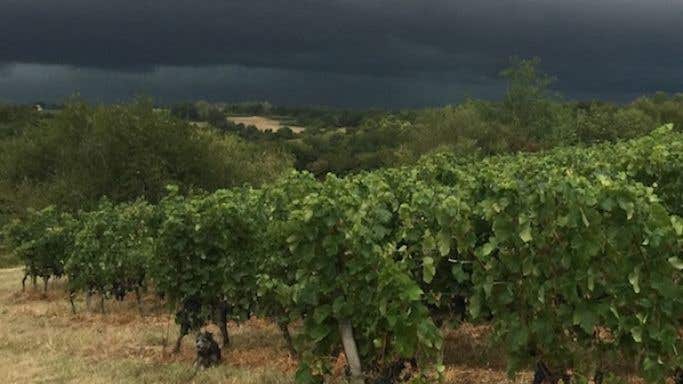Gavin Quinney of Ch Bauduc outside Créon in the Entre-Deux-Mers brings us bang up to date.
It's five weeks since my mid-August report on Bordeaux 2016’s bone-dry summer, so here's an update on how things are shaping up for the harvest. The white wine harvest is already well under way as we await the Merlots and Cabernets.
The 'bone-dry summer’ continued, in fact, for four more weeks until the night of 13 September. It had proved to be exceptionally dry. For the 12 weeks from 23 June (that infamous date seems a long time ago now), many areas of Bordeaux saw only a tenth of the 30-year average rainfall: St-Émilion, Sauternes, Margaux and parts of the Entre-Deux-Mers had just 14 mm (0.55 in) compared with the average of 140 mm (5.5 in). Even Blaye, which registered more rain than most regions, had only 30 mm (1.2 in) in those 12 weeks – less than a quarter of the norm. It was also hot for long stretches, but as you can see from the chart below, the night-time temperatures were not unbearably high, and the switch between cooler nights and daytime heat was beneficial for the vines.
The lengthy drought ended with a bang last Tuesday evening, with a thunderous storm (pictured above) that had worryingly come with a hail warning. A few hailstones caused anxious moments as they tapped on the windows but mercifully there was nothing more serious than that. The vineyards did, though, get a proper dousing, and not before time. The figures in my temperature and rainfall graph below refer to my local weather station. St-Émilion and the far north of the Médoc had a bit less with 32 mm (1.26 in), while Margaux, St-Estèphe and Léognan had 47-51 mm (1.85-2 in) last Tuesday and Wednesday.

The night of 13 September also seemed to usher in the autumn, with cooler daytime temperatures and noticeably chillier mornings. It feels that we’ve now entered the third and final stage of this year's growing season. Spring was wet and relatively cold, summer was very dry and comfortably hot, and now the build up to the autumn harvest, and the harvest itself, will be dry, sunny and fresh – with any luck, of course. The forecast, at least, seems fine for the moment, and that rain might just be the refreshment that the vines called out for.
Much depends on the subsoils and how the root systems coped with the lack of any summer rain. See the table below for a comparison of recent vintages. Many better-placed vines look in a remarkably good state, while younger plants on more porous or drier ground have undoubtedly suffered. It would though, I think, be a mistake to assume it's just a case of the top appellations versus the rest: some parcels or rows in, say, Pomerol and Margaux look markedly parched, while others in the (less expensive) Côtes look as fresh as a daisy. And vice versa.

The red wine vines do need some water stress in summer to produce the best fruit but the roots need access to just enough moisture. Fortunately the wet spring put enough in reserve for many estates.

As with last year, the argilo-calcaire (clay-limestone) terroirs of St-Émilion (pictured above), for example, appear to be in rude health despite the drought. (Last year though there was rain in August.)
On the left bank, certain plots of the Haut-Médoc and the famous appellations within its borders have also coped really well (see Ch Lafite in Pauillac pictured below with Cabernet on the left and Merlot on the right), while others had vines that were noticeably flagging – at least until last week’s rain.

Yields have been affected by the drought but there are plenty of heavily-laden bunches, especially on the Merlot vines. The overall crop size should be good, thanks to excellent flowering on the Merlot, which makes up two-thirds of the red wine crop in Bordeaux (and nearly 90% of the vineyards are red). That's the third good production in a row following on from the poor yield of 2013.
It will be fascinating to see how the prolonged stress will have stamped its character on the vineyard sites and the resulting wines. Much will depend on the run-in for the reds, both with the weather and the decision-making over harvest dates. After tasting red grapes from around the region, I'd suggest there’s no rush to pick. The rain may have caused a little dilution, but given a few weeks of dry, sunny weather, the prospects are exciting if the weather holds.

The dry whites have been and are currently being picked in the Graves and Pessac-Léognan (the first grapes were harvested at the beginning of the month) and now also in the Entre-Deux-Mers (pictured at Bauduc above). These recent chilly mornings have been terrific for the Sauvignons and Sémillons. Meanwhile, some of the larger ’caves’ or co-ops have finished picking their whites already. ’They want to make a safe wine like one from Gascony’, said one dismissive neighbour, a former head of the Entre-Deux-Mers syndicate. He started his whites today.
Given that we haven't seen a growing season quite like this, I suspect there'll be a few debates about what and when to pick. And that's even before consulting the weather forecast.
If you want to see how the Bordeaux harvest progresses, I'll be posting plenty of images on Twitter and Instagram @GavinQuinney using #bdx16.
